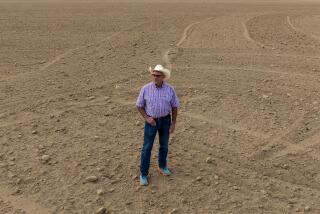Town Sustained by Black Gold Shows Off Oil Industry Relics
- Share via
TAFT, Calif. — The 36 third-graders were full of questions as they explored the grounds of the West Kern Oil Museum on a recent weekday, gawking at the towering 1917 wooden derrick and climbing on no-longer-used oil pumps, wheels, trucks and other equipment.
They knew the right questions to ask.
“These youngsters have grown up with oil. They take oil for granted. In our school, 90% of the students’ parents work for oil companies,” said Carla Arnold, who teaches the third-graders from Taft’s Jefferson School. Her husband is an oil field foreman.
Taft, population 5,900, is in the heart of one of the richest oil fields in America. Jane Kinsey, volunteer curator of the Oil Museum, told the youngsters the importance of oil to Kern County:
“Kern County has been America’s leading oil-producing county for years. If Kern County were a state, it would be the fourth-largest-producing oil state in the nation.”
She noted that 13,500 people work for the oil industry in Kern County. Oil revenues in the county last year were $3.65 billion.
The West Kern Oil Museum is filled with photographs and artifacts. An old one-story oil company office building was moved onto the grounds in 1980 to house the memorabilia that tells the story of oil from the well to the refinery.
Scattered over the spacious grounds are several acres of oil field relics, including pre-World War I trucks, pumps, wheels and kilns.
“I always wondered what all this stuff was out here,” Lacy Curry, 8, said.
“How old did you say this old wooden derrick is?” classmate Justine Ellzey asked.
Museum volunteer Agnus Hardt said the derrick was built in 1917. “How old does that make it?” she quizzed the youngsters.
Student Kaysha Streich took a stick and drew the number 88 on the patch of dirt on the ground. She scratched out 17 beneath the 88, ran a line under the two figures, subtracted and volunteered: “The derrick is 71 years old. Is there oil in the ground beneath the derrick, and does the derrick still work?” she asked.
Hardt said that it does but that the derrick is too old, too risky to operate. She noted that when the derrick was erected, the workers did not wear hard hats or safety belts.
“Many men fell from the derricks as they built them. Some were crippled for life. Some were killed. It was dangerous work. The men worked 12-hour shifts,” she said.
Her father came from Scotland in 1925 to work in the Taft oil fields. Her husband works in them now.
The tracks of the Sunset Western Railroad run by the museum property. “We studied about that railroad last year,” piped up Tiffany Annable.
Hardt said the railroad first came to Taft in 1909. “In 1910-12 we had an oil boom. Taft had the busiest railroad depot in America at the time,” the museum volunteer said.
“In 1910 and 1911, special trains were run to Taft so people could see the famous Lakeview Gusher that blew in on March 15, 1910. It demolished the derrick and had an uninterrupted flow for 544 days with as many as 90,000 barrels of oil a day gushing from the ground.”
This uncommon Oil Museum is open to the public Wednesday, Saturday and Sunday from 1 p.m. to 4 p.m. School groups tour throughout the week.
“We knew a lot about oil before we came here, but we know much more about oil now that we’ve been through the museum,” Lacy Curry said.
More to Read
Sign up for Essential California
The most important California stories and recommendations in your inbox every morning.
You may occasionally receive promotional content from the Los Angeles Times.













